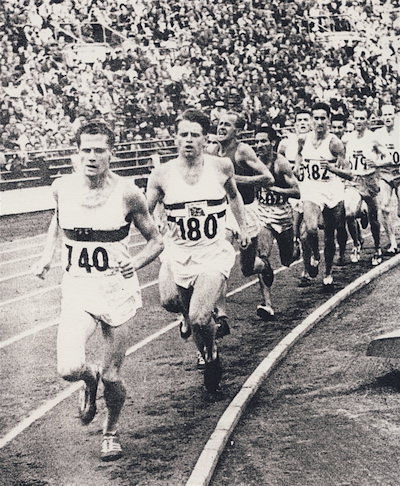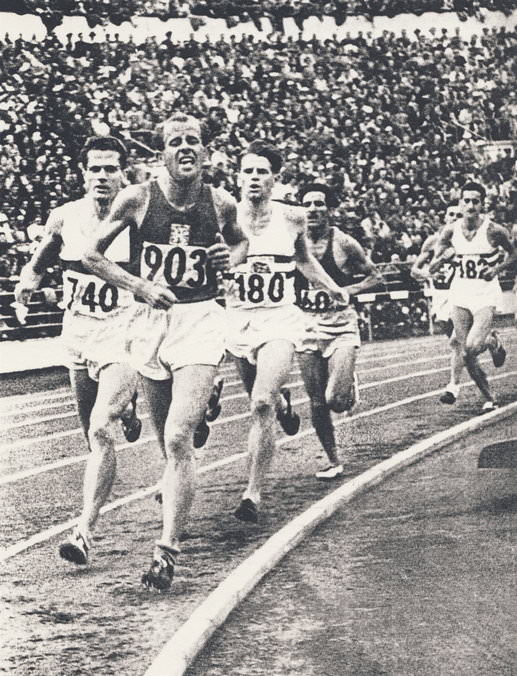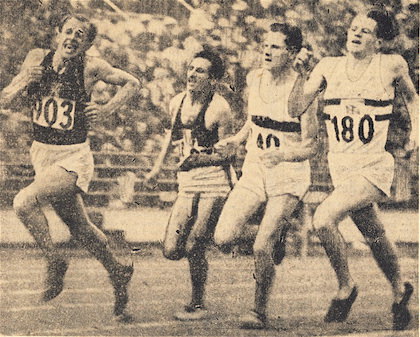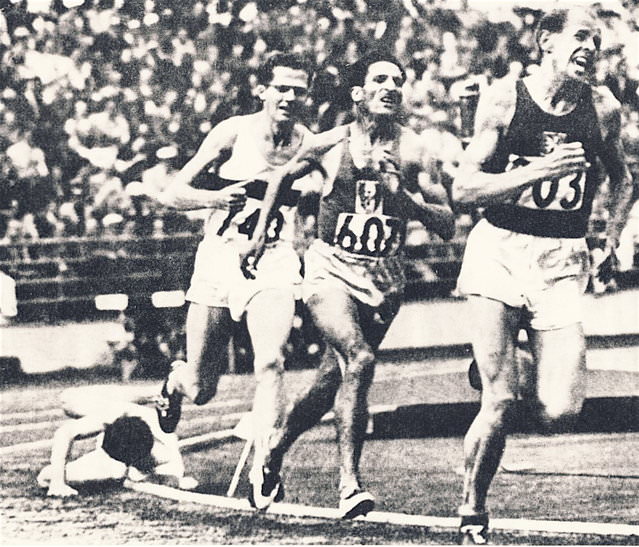Articles / Great Races
Chataway v Mimoun v Schade v Zatopek (5,000, 1952)
By John Cobley
16th February 2011
Chataway v Mimoun v Schade v Zatopek
1952 5,000 OLYMPIC FINAL
July 24, 1952, Helsinki, Finland
Great Races #7
With six runners all thought to have a chance of winning, this Olympic final promised to be a dandy. Herbert Schade, 30, of Germany had the best time over this distance in the 1952 season. The already crowned 10,000 victor, Emil Zatopek, 30, admitted publicly that the German was the one to watch. After all, the German’s best 1952 time was ten seconds faster than Zatopek’s. But there were many who thought that the Czech’s amazing competitive spirit would win out. Then the man who beat him in the 1948 5,000, Gaston Reiff, 31, was also in the field: if he could do it once, he could do it again, though perhaps that would be unlikely as he had not been in top form. Then there was the brilliant Algerian-born Frenchman Alain Mimoun, 31. He now had two Olympic 10,000 silver medals to his name, both behind Zatopek. He was in good form and had to be able to beat the Czech one day. Finally, there were two young 21-year-old Englishmen, Christopher Chataway and Gordon Pirie. Both were improving fast and both were capable of a big breakthrough.
Gordon Pirie perhaps summed up the race best: “The final was a real nerve-tester.” (Running Wild, p.93) In the pre-race talk, Schade had announced that his plan was to make use of his fast time and run away from the field. Zatopek, in a friendly gesture that had a tinge of guile, warned Schade that leading was difficult and tiring. Pirie, privately, was planning to make his effort at around 4,000.
 |
| Early stages: Chataway (180)and Zatopek follow Schade. |
Despite Zatopek’s warning, Schade went straight into the lead, taking the field through 1,000 in 2:47, which was world-record 13:55 speed. Zatopek, trailed by Pirie, ran easily at the back of the 15-man field. However, at 1K he saw a gap opening behind the front five and moved up quickly to join the lead group, with Pirie still on his tail. The top six favorites were already in the lead.
Schade continued the fast pace and led at 2K in 5:37, 14:02 speed. Within half a lap Zatopek went to the front, but then Schade quickly took the lead back. Zatopek later said he then told Schade he would be happy to help with the lead. So Zatopek was allowed back into the lead, passing 3K in 8:30. The third K was the slowest yet (2:53). Was Zatopek slowing the pace deliberately?
Perhaps sensing this, Mimoun, Reiff and Chataway passed him. Then Schade made a bid at 3200. But Zatopek still wanted the lead, and he went by Schade. He then held off an attack by Reiff.
 |
| Zatopek leads as Pirie (182) drops from from the leading group. |
Pirie, who had sensibly stayed in sixth place while the others jostled for the lead and ran an erratic pace, was tired at this point. Nevertheless, he still decided to follow his plan and try to break away before the last kilometre. But he was in the lead for less than 200 metres before the others, except Reiff, passed him. 4K was reached in 11:25 with the six leaders in a bunch. Then Reiff dropped out.
It was Schade who took the lead from Pirie ahead of Chataway, Mimoun, Reiff and Zatopek. Pirie lost contact on the penultimate lap and was 10m behind the leading group of four at the bell. Going into the last lap, the German still led. Then after Zatopek had taken the lead briefly, Schade decided to go for broke at the crown of the bend (340 to go). Chataway now came into the picture; as he had kept on the German’s heels round the bend, he was able to burst into the lead along the back straight. Mimoun looked out of the race after Schade’s burst, but he pulled back to the others and even passed Zatopek with 210 to go.
 |
| At the crown of the last bend, all four leaders abreast: Zatopek, Mimoun, Schade and Chataway. |
Going into the final bend, Chataway was giving his all at the front, but his head was already going back. The three others were all waiting to pounce. Schade had the best position on the shoulder of Chataway; Mimoun was trapped on the inside and had to slow to get outside Chataway; Zatopek was hovering just behind the other three and moving wide, ready to pass. It was still anyone’s race.
Just past the crown of the bend all four were abreast: Chataway, Schade, Mimoun and Zatopek, with Emil almost in the third lane. Suddenly, Zatopek was past the others in a flash. "I saw him level with me too late--he had already picked up his pace, and you can't make up five meters on an athlete of his class," Mimoun told French reporters. (runningtimes.com)
Mimoun and Schade definitely bumped each other at this point. Schade in turn was forcing Chataway against the track edge in a desperate move to get by the Englishman. The film of the race shows Chataway taking one step on the inside of the track just as Schade cuts in ahead of him. Then, after a couple of strides back on the track, the Englishman went down—just after the other three had gone ahead. The film suggests that Chataway’s fall was partly the result of his being crowded onto the edge of the track by Schade. Certainly the lactic acid in his legs would have made it more difficult for him to keep his balance, but his fall was not totally his fault. However, there is no doubt he would have still been out of the medals.
 |
| Chataway falls while Zatopek charges to victory. |
After Chataway’s fall, Zatopek powered to the finish. Mimoun hung on tenaciously, looking at about 80m from the finish that he might even catch his nemesis. However, Zatopek somehow found another gear and won clearly. His last lap was 58.1. Schade appeared resigned to third place.
Meanwhile, Chataway had been able to get up quite quickly. He laboured through the last 120m only to be caught on the line by Pirie, who afterwards noticed “an awful graze”on Chataway’s leg. He said, “Chris told me he had fallen over in his exhaustion.” (RW, p.94)
1. Zatopek CZE 14:06.6; 2. Mimoun FRA 14:07.4; 3. Schade GER 14:08.6; 4. Pirie GBR 14:18.0; 5. Chataway GBR 14:18.0; 6. Perry AUS 14:23.6. 
2 Comments